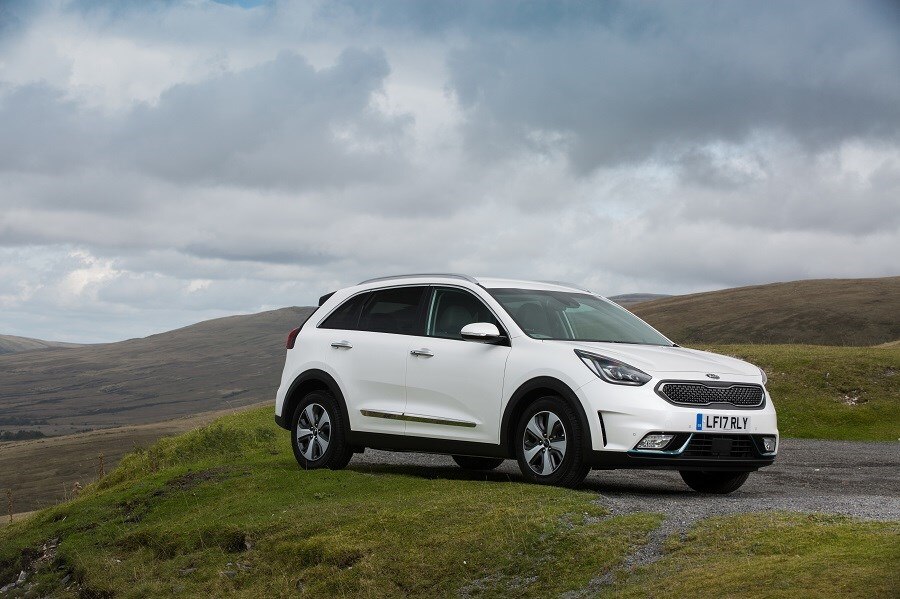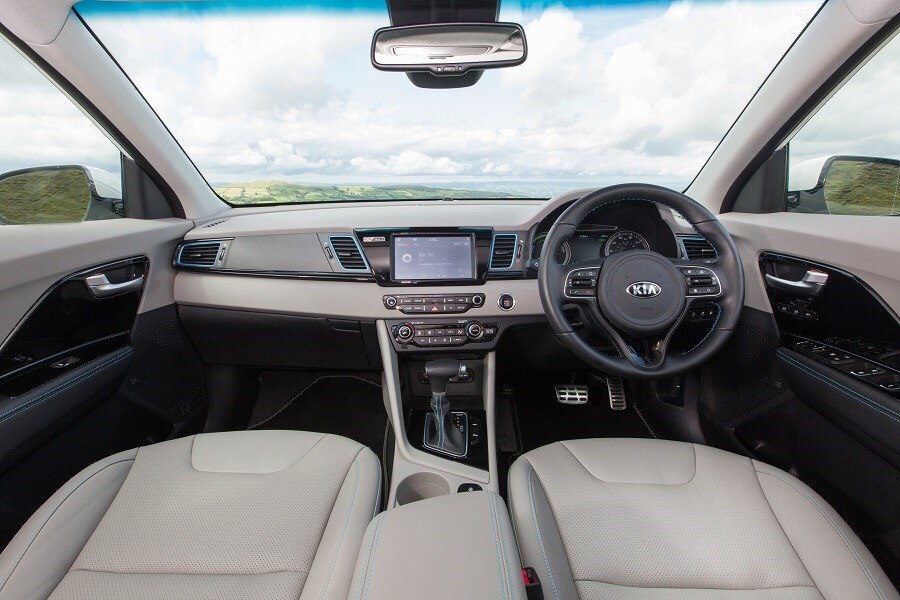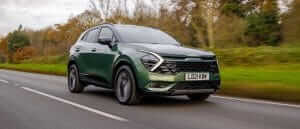Model Review
The Niro is a new addition to the Kia line-up and sits below the Sportage as a crossover SUV. It is built on a platform specifically developed by the Korean brand to be used on plug-in hybrids.
As a PHEV, it benefits from decent fuel economy and refined performance, with a focus on it being a relaxing car to drive for family motorists.
Inside, there are other types of new technology, too, with Kia positioning the Niro as its most futureproof model.
State-of-the-art infotainment, radar-guided cruise control and LED lighting elements are just a few of these.
In addition, it features the key selling points that make Kia such a popular choice with pragmatic drivers, namely a combination of practicality, affordability and the peace-of-mind offered by a seven-year warranty.
Latest model
There’s only one model, which joined the Kia line-up in 2017 - though there are other versions of the Niro available as well, all featuring a form of hybrid powertrain.
The ‘conventional’ Niro Hybrid features a self-charging hybrid electric system similar to that of the Toyota Prius, with official emissions of 86g/km and 74.8mpg.
The PHEV takes that further though. On the NEDC cycle, it returns up to 217.3mpg and has CO2 emissions of just 25g/km. Though in real-world driving conditions and over long journeys these figures aren’t the most realistic.
Kia is very keen to play the Niro PHEV’s eco-card, to the extent of it wearing ice blue scallops around the front fog lamps to mark it out as different from a normal Niro. There are no plans to offer any other trim levels on the Niro PHEV, which itself is based on Kia’s top-of-the-range Niro 4, with a comprehensive equipment package to match.
Value for money
At £30,845, the Niro might appear to be an expensive Kia, but that would be an unfair judgement given the specification on offer and the pricing of some of its key rivals. For example, it’s £1,300 cheaper than the MINI Countryman SE Hybrid yet it is far larger and better equipped.
Included in the price are 16-inch alloy wheels, an eight-inch touchscreen satellite navigation system with European mapping, an eight-speaker JBL premium sound system, Kia’s Connected Services including TomTom, black leather upholstery, parking sensors at both ends, heated seats and steering wheel, radar-guided cruise control and autonomous emergency braking (AEB).
It also gets wireless phone charging, Apple CarPlay and Android Auto smartphone mirroring and a lane-keeping assistance system.
Add in Kia’s industry-leading 100,000-mile, seven-year warranty, along with projected strong resale values for PHEVs across the board and the value-for-money case really starts to stack up.
If your vehicle usage pattern means a PHEV will also significantly reduce your fuel bills, then the fuel saving also need to be taken into account. If PHEV as a concept works for you, then the Niro is a tempting proposition.
Looks and image
Sadly, the Niro isn’t a car that will win any beauty contests. It seems to have a bit of an identity crisis too as it’s an SUV, a crossover, and an estate car all in one—meaning that it combines a low ride height with a large, bulky body.
It’s incongruous to start with, but the appearance isn’t helped by a very different styling theme at both the front and rear.
At the front, the look echoes of that of the Sportage, with large ovoid headlamps and a wide, gaping grille. The styling strakes under the fog lamps lift the front end styling slightly, but it’s still a large and bulky-looking car.
Meanwhile, the rear-end is flatter and squarer with styling cues that ape those of the Rio, with almost-rectangular LED lights and a flat, square tailgate.
In profile, the standard 16-inch alloys do the car no favours—the large expanses of sheet metal mean that, on the standard rims, it looks significantly under-styled. Specify the optional 18s and things improve, but at the expense of ride comfort.
Aesthetically, the Niro lags behind several of its rivals, but if you put substance over style it’s generally inoffensive. Just don’t expect to gaze back at it fondly in a car park.
Space and practicality
Inside, the Niro is well-finished and smartly laid out, with the dashboard dominated by the eight-inch touchscreen, which operates the audio, sat-nav and climate controls, as well as being the car’s interface between Apple CarPlay and Android Auto.
Ergonomically, it’s pretty sensible, though some drivers won’t get on with its foot-mounted parking brake but with no manual transmission option, this is less of an issue than it could be.
Also, unusually for such a tech-laden car, there’s no keyless entry or ignition option, meaning you start it with a conventional key. Whilst this is hardly an inconvenience, is it something of a surprise for a model with an ultra-modern powertrain.
In terms of passenger space, the Niro fares very well indeed. The front seats are comfortable with multiple adjustment options, while leg, head and shoulder room is up there among the best in its class.
Back seat passengers have it good too, with room for three adults to sit abreast, while the high seating position aids legroom. The wide door apertures also make it relatively easy to install child seats.
Boot space is impressive too, with a flat, wide and square loading area. A 60:40 split rear seat back also aids practicality.
As a family car, the Niro has a lot going for it.
Engines
The Niro PHEV is a plug-in hybrid, which in simple terms means it has a 1.6-litre four-cylinder petrol unit paired with an electric motor. Unlike a pure electric vehicle, with a PHEV there’s a direct drive relationship between the front wheels and the engine.
In petrol mode, the engine has 139bhp and 265Nm of torque, fed to the wheels via a six-speed automatic gearbox meaning acceleration of 0-60mph in 10.4 seconds and a top speed of 107mph.
The battery pack is an 360v 8.9kWh lithium-ion polymer unit, with a power output of 59KW.
Power delivery is smooth and linear, but the Niro isn’t a car for enthusiastic drivers—it has extremely light steering while the added weight of the battery pack makes it a bit ponderous on fast A and B-roads.
Running costs
On paper, the Niro PHEV’s running costs are sensational, but the headline figure of 217.3mpg is based on the outgoing NEDC drive cycle and is representative of the car being driven under very specific, fixed mileage conditions.
In real terms, most owners report getting between 50mpg and 65mpg on average, depending on how they use their car. It’s nowhere near the published mpg figure, but it’s not bad for a car of the Niro’s bulk.
Insurance costs reflect the type of owner the Niro is expected to attract and are fairly low in group 13, while the popularity of PHEVs on the second-hand market meaning that for now at least, it’ll also hold its value fairly well.
Things to look for
There are no real reported problems with the Niro PHEV and any that do arise will still be covered by Kia’s warranty. Do make sure that any used car option comes with all the correct charging equipment, though.
Rivals
MINI’s Countryman SE Hybrid is an obvious competitor, as is the Mitsubishi Outlander PHEV - though the latter is bigger and more of a ‘proper’ SUV. Smaller alternatives that use similar tech include the Hyundai Ioniq and the Toyota Prius PHEV.
Depreciation
With both a seven-year warranty and the popularity of plug-in hybrids on the used market behind it, the Niro PHEV is expected to hold its value pretty well. Over a three-year period, you can expect it to retain almost 50 per cent of its original value.





